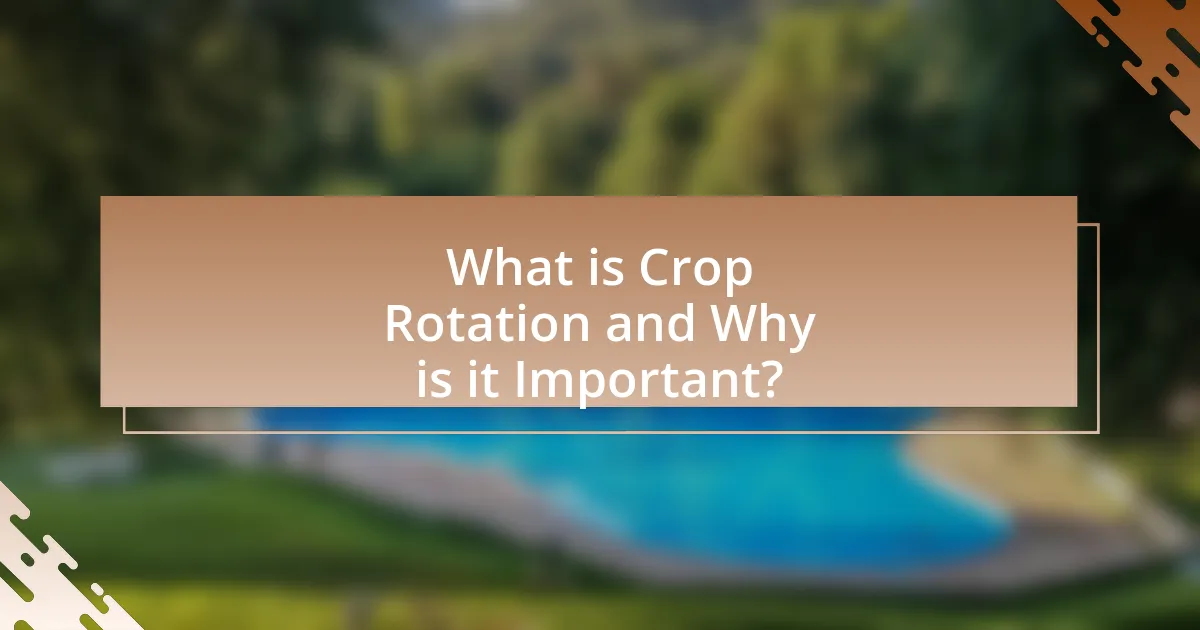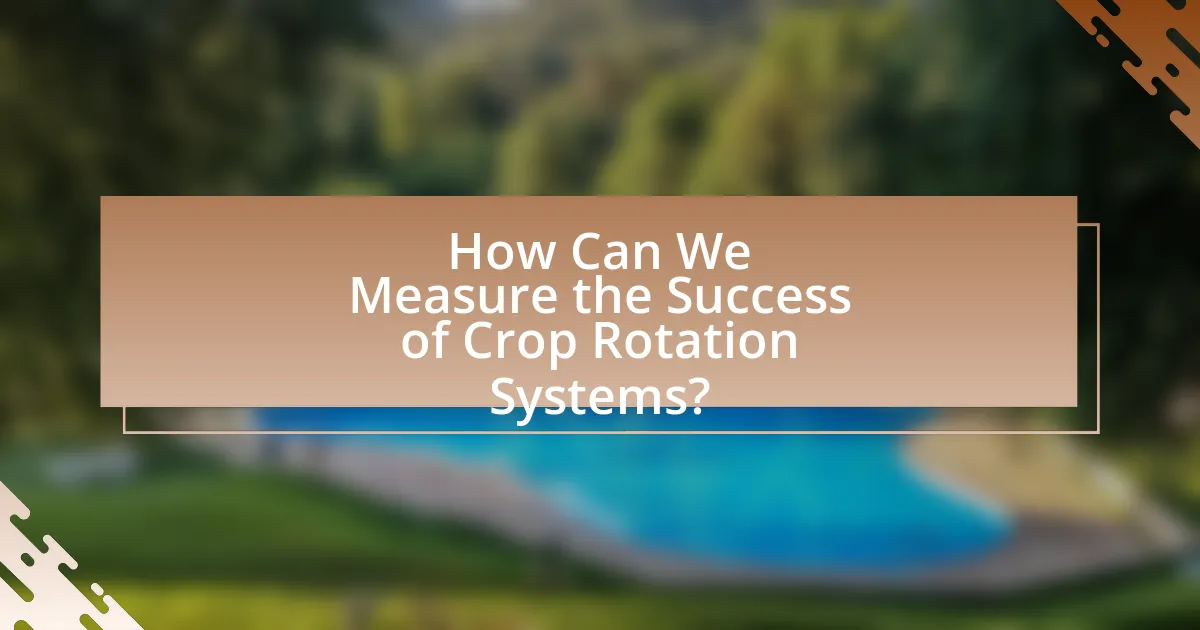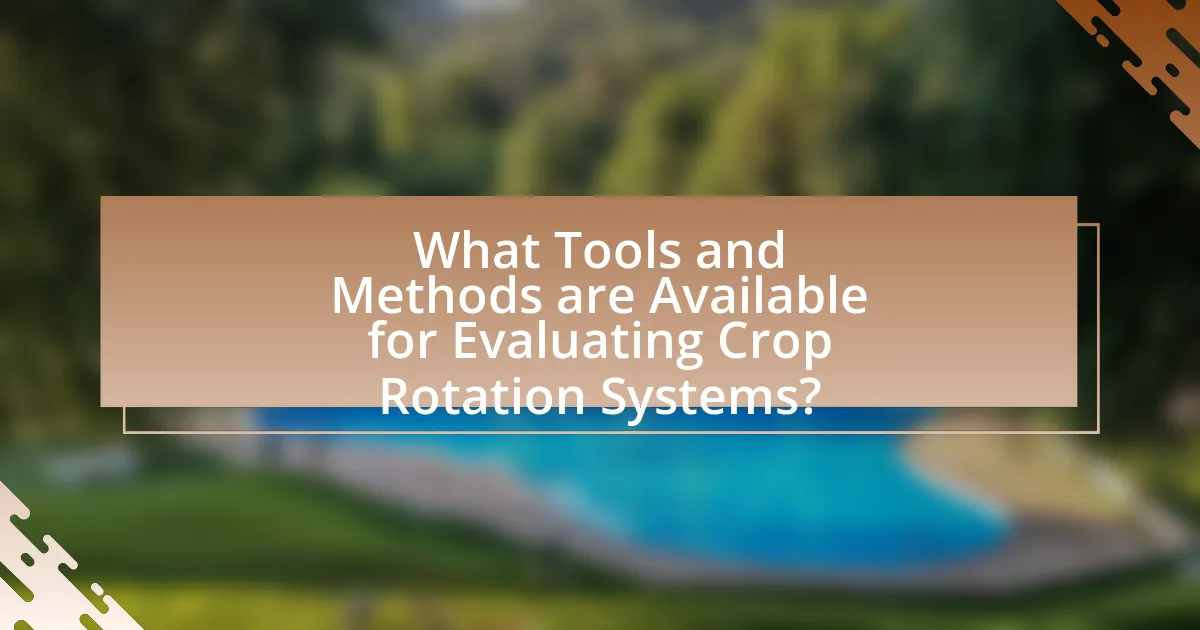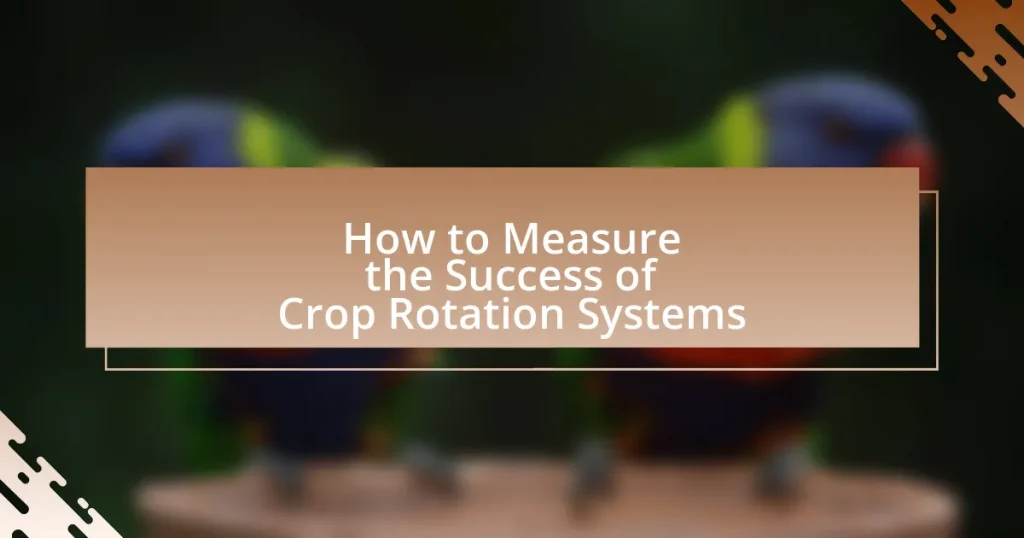Crop rotation is an essential agricultural practice that involves alternating different types of crops in a specific area over time to enhance soil fertility, reduce pest and disease cycles, and improve crop yields. This article examines the significance of crop rotation, its impact on soil health, and the various systems employed, such as simple and complex rotations. Key indicators for measuring the success of crop rotation systems include soil health, crop yield, pest management, and economic viability. Additionally, the article discusses tools and methods for evaluating these systems, including precision agriculture technologies and traditional assessment techniques, providing a comprehensive framework for understanding the effectiveness of crop rotation in sustainable agriculture.

What is Crop Rotation and Why is it Important?
Crop rotation is the agricultural practice of alternating the types of crops grown in a particular area across seasons or years. This method is important because it enhances soil fertility, reduces pest and disease cycles, and improves crop yields. For instance, rotating legumes with cereals can increase nitrogen levels in the soil, which benefits subsequent crops. Research indicates that crop rotation can lead to a 20-30% increase in yields compared to continuous cropping systems, demonstrating its effectiveness in sustainable agriculture.
How does crop rotation contribute to soil health?
Crop rotation enhances soil health by improving nutrient availability, reducing soil erosion, and promoting biodiversity. Different crops have varying nutrient requirements and root structures, which help maintain soil fertility and structure. For instance, legumes, when included in a rotation, fix atmospheric nitrogen, enriching the soil for subsequent crops. Research indicates that crop rotation can increase organic matter content and microbial diversity, leading to healthier soil ecosystems. A study published in “Agronomy Journal” by Drinkwater et al. (1998) found that diverse crop rotations significantly improved soil quality indicators compared to continuous cropping systems.
What specific soil properties are improved through crop rotation?
Crop rotation improves several specific soil properties, including soil fertility, structure, and microbial activity. By alternating different crops, nutrient depletion is minimized, as diverse root systems enhance soil structure and promote better aeration and water retention. Additionally, certain crops, such as legumes, fix nitrogen in the soil, thereby increasing its fertility. Research indicates that crop rotation can lead to a 20-30% increase in soil organic matter, which is crucial for maintaining soil health and productivity.
How does crop rotation affect soil nutrient levels?
Crop rotation enhances soil nutrient levels by promoting a diverse range of crops that contribute different nutrients to the soil. For instance, legumes, when included in a rotation, fix atmospheric nitrogen, enriching the soil with this essential nutrient. Research indicates that fields with diverse crop rotations can exhibit up to 20% higher soil organic matter compared to monoculture systems, which directly correlates with improved nutrient availability. Additionally, rotating crops can disrupt pest and disease cycles, reducing the need for chemical fertilizers and allowing natural soil processes to maintain nutrient levels effectively.
What are the different types of crop rotation systems?
The different types of crop rotation systems include simple rotation, complex rotation, and cover cropping. Simple rotation involves alternating two or more crops in a specific sequence, which helps in pest and disease management. Complex rotation incorporates a wider variety of crops over multiple seasons, enhancing soil fertility and biodiversity. Cover cropping, on the other hand, involves planting crops specifically to cover the soil, improving soil health and preventing erosion. These systems are validated by agricultural studies showing improved yields and reduced soil degradation when diverse crop rotations are implemented.
What is the difference between simple and complex crop rotation?
Simple crop rotation involves alternating two or three different crops in a specific sequence over time, while complex crop rotation incorporates a wider variety of crops, often including multiple species and cover crops, in a more intricate pattern. Simple crop rotation typically focuses on the benefits of reducing pest and disease cycles, while complex crop rotation enhances soil health, biodiversity, and nutrient cycling through a more diverse planting strategy. Research indicates that complex systems can lead to improved yields and resilience against environmental stressors compared to simpler systems, as evidenced by studies showing that diverse rotations can increase soil organic matter and microbial activity.
How do seasonal and perennial crop rotations differ?
Seasonal crop rotations involve planting different crops in a specific sequence within a single growing season, while perennial crop rotations consist of planting crops that grow for multiple years without needing to be replanted each season. Seasonal rotations can enhance soil fertility and reduce pest cycles by alternating crops, as evidenced by studies showing improved yields and reduced disease incidence. In contrast, perennial rotations contribute to soil health and biodiversity over time, as they establish deeper root systems and require less frequent tillage, which can lead to better soil structure and moisture retention.

How Can We Measure the Success of Crop Rotation Systems?
The success of crop rotation systems can be measured through several key indicators, including soil health, crop yield, pest and disease management, and economic viability. Soil health can be assessed by measuring organic matter content, nutrient levels, and microbial activity, which are often enhanced by diverse crop rotations. Crop yield data provides direct evidence of the effectiveness of rotation practices, with studies showing that crop rotation can increase yields by 10-30% compared to monoculture systems. Additionally, monitoring pest and disease incidence can indicate the success of crop rotation in disrupting pest life cycles and reducing outbreaks. Economic viability can be evaluated through cost-benefit analyses, which demonstrate that crop rotation can lead to reduced input costs and increased profitability over time. These metrics collectively provide a comprehensive framework for assessing the effectiveness of crop rotation systems.
What key indicators should be used to assess crop rotation success?
Key indicators to assess crop rotation success include soil health, crop yield, pest and disease pressure, and nutrient availability. Soil health can be measured through indicators such as organic matter content and microbial activity, which reflect the soil’s ability to support plant growth. Crop yield is a direct measure of the effectiveness of the rotation system, with higher yields indicating successful management practices. Pest and disease pressure can be evaluated by monitoring the incidence and severity of infestations, as effective rotations typically reduce these issues. Nutrient availability can be assessed through soil tests that measure levels of essential nutrients, ensuring that crops receive adequate nourishment. These indicators collectively provide a comprehensive assessment of crop rotation success.
How do yield metrics reflect the effectiveness of crop rotation?
Yield metrics directly indicate the effectiveness of crop rotation by measuring the quantity and quality of crops produced over time. Effective crop rotation typically leads to improved soil health, reduced pest and disease pressure, and enhanced nutrient availability, which collectively contribute to higher yields. For instance, studies have shown that rotating crops can increase yields by 10-30% compared to continuous cropping systems, as diverse root structures and nutrient uptake patterns optimize soil resources. Additionally, yield metrics can reveal trends over multiple seasons, allowing farmers to assess the long-term benefits of specific rotation practices, such as increased resilience to environmental stressors and improved soil fertility.
What role does pest and disease management play in measuring success?
Pest and disease management is crucial in measuring success as it directly impacts crop yield and quality. Effective management strategies reduce the incidence of pests and diseases, leading to healthier crops and increased productivity. For instance, studies have shown that integrated pest management (IPM) can enhance crop yields by up to 20% while minimizing chemical inputs. This quantifiable improvement in yield serves as a key performance indicator for the success of crop rotation systems, demonstrating that successful pest and disease management is integral to achieving optimal agricultural outcomes.
How can economic factors influence the assessment of crop rotation systems?
Economic factors significantly influence the assessment of crop rotation systems by affecting profitability, input costs, and market demand for various crops. For instance, the cost of seeds, fertilizers, and labor can determine which crops are viable for rotation, impacting overall yield and economic returns. Additionally, fluctuating market prices for different crops can lead farmers to prioritize certain rotations that maximize profit, thereby influencing their long-term sustainability and soil health. Research indicates that effective crop rotation can enhance soil fertility and reduce pest pressures, which in turn can lower production costs and increase net income, demonstrating the interconnectedness of economic viability and agronomic practices.
What are the cost-benefit analyses relevant to crop rotation?
Cost-benefit analyses relevant to crop rotation assess the economic advantages of improved soil health, increased yields, and reduced pest and disease pressure against the costs of implementing diverse cropping systems. Research indicates that crop rotation can enhance soil fertility and structure, leading to a 10-20% increase in crop yields compared to monoculture systems, which translates to higher revenue for farmers. Additionally, studies show that rotating crops can reduce the need for chemical fertilizers and pesticides, resulting in lower input costs; for instance, a study by the USDA found that farmers practicing crop rotation saved up to 30% on pest management costs. These analyses help farmers make informed decisions by quantifying the long-term benefits of sustainable practices against the initial investment required for transitioning to crop rotation systems.
How do market trends affect the perceived success of crop rotation?
Market trends significantly influence the perceived success of crop rotation by affecting the economic viability of different crops. When market demand favors certain crops, farmers may view crop rotation as successful if it aligns with those profitable options. For instance, if there is a surge in demand for soybeans, farmers practicing crop rotation that includes soybeans may perceive their system as more successful due to higher potential profits. Conversely, if market trends shift away from crops included in a rotation, the perceived success may diminish, regardless of the agronomic benefits of the practice. This relationship is supported by data indicating that crop profitability directly impacts farmers’ decisions and perceptions regarding agricultural practices, as seen in studies conducted by agricultural economists.

What Tools and Methods are Available for Evaluating Crop Rotation Systems?
Tools and methods available for evaluating crop rotation systems include soil health assessments, yield monitoring, and economic analysis. Soil health assessments utilize indicators such as organic matter content, nutrient levels, and microbial activity to gauge the impact of different crop rotations on soil quality. Yield monitoring involves tracking crop outputs over time to determine the productivity associated with specific rotation practices. Economic analysis evaluates the cost-effectiveness of various crop rotations by comparing input costs and market prices against the yields produced. These methods collectively provide a comprehensive understanding of the effectiveness and sustainability of crop rotation systems.
What technological tools can assist in measuring crop rotation success?
Technological tools that assist in measuring crop rotation success include precision agriculture software, soil health monitoring sensors, and yield mapping technology. Precision agriculture software, such as Climate FieldView and Ag Leader, enables farmers to analyze data on crop performance and soil conditions, allowing for informed decisions on crop rotation. Soil health monitoring sensors provide real-time data on soil nutrients, moisture levels, and microbial activity, which are critical for assessing the impact of different crops on soil health over time. Yield mapping technology, often integrated with GPS systems, allows farmers to visualize yield variations across fields, helping to evaluate the effectiveness of crop rotation strategies. These tools collectively enhance the ability to measure and optimize crop rotation success through data-driven insights.
How do precision agriculture tools enhance crop rotation evaluation?
Precision agriculture tools enhance crop rotation evaluation by providing data-driven insights that optimize decision-making. These tools utilize technologies such as GPS, remote sensing, and soil sensors to collect real-time data on soil health, moisture levels, and crop performance. For instance, a study published in the journal “Precision Agriculture” found that using soil moisture sensors can lead to more informed decisions about crop rotation, resulting in yield increases of up to 20%. By analyzing this data, farmers can assess the effectiveness of different crop combinations, identify nutrient deficiencies, and adjust their practices accordingly, ultimately improving the sustainability and productivity of their farming systems.
What role do data analytics play in assessing crop rotation outcomes?
Data analytics play a crucial role in assessing crop rotation outcomes by enabling farmers to analyze historical yield data, soil health metrics, and environmental conditions to optimize crop selection and rotation schedules. By utilizing statistical models and machine learning algorithms, farmers can identify patterns and correlations that inform decisions on which crops to plant in succession, ultimately improving soil fertility and increasing overall yield. For instance, a study published in the journal “Agricultural Systems” demonstrated that data-driven crop rotation strategies led to a 20% increase in yield compared to traditional methods, highlighting the effectiveness of analytics in enhancing agricultural productivity.
What traditional methods are still relevant for evaluating crop rotation systems?
Traditional methods still relevant for evaluating crop rotation systems include soil fertility assessments, yield comparisons, and pest and disease monitoring. Soil fertility assessments involve analyzing nutrient levels and organic matter content to determine the impact of different crop sequences on soil health. Yield comparisons measure the productivity of various crops in rotation, providing insights into the effectiveness of the system. Pest and disease monitoring tracks the prevalence of agricultural pests and diseases, which can be influenced by crop rotation practices. These methods have been used historically and continue to provide valuable data for optimizing crop rotation systems.
How can farmer observations contribute to measuring success?
Farmer observations can significantly contribute to measuring success by providing real-time data on crop performance, soil health, and pest management. These observations allow farmers to assess the effectiveness of crop rotation systems by identifying patterns in yield variations and soil nutrient levels over time. For instance, a study published in the “Agricultural Systems” journal found that farmers who documented their observations reported improved decision-making, leading to a 20% increase in crop yields when implementing effective rotation strategies. This evidence underscores the value of farmer insights in evaluating and enhancing agricultural practices.
What historical data should be considered in evaluations?
Historical data that should be considered in evaluations of crop rotation systems includes past crop yields, soil health indicators, pest and disease prevalence, and climatic conditions. Analyzing historical crop yields provides insights into the productivity of different rotation systems over time, while soil health indicators, such as organic matter content and nutrient levels, reveal the long-term effects of crop rotations on soil quality. Additionally, data on pest and disease occurrences helps assess the effectiveness of rotations in managing agricultural challenges. Finally, understanding historical climatic conditions allows for the evaluation of how environmental factors have influenced crop performance and rotation success.
What are some best practices for implementing and measuring crop rotation systems?
Best practices for implementing and measuring crop rotation systems include selecting diverse crops, planning rotations based on nutrient needs, and monitoring soil health. Diverse crop selection enhances soil fertility and reduces pest and disease cycles, while planning rotations according to the specific nutrient requirements of each crop optimizes resource use. Regular soil testing and monitoring of crop yields provide measurable data to assess the effectiveness of the rotation system. Research indicates that farms employing diverse crop rotations can increase yields by up to 20% compared to monoculture systems, demonstrating the tangible benefits of these practices.










